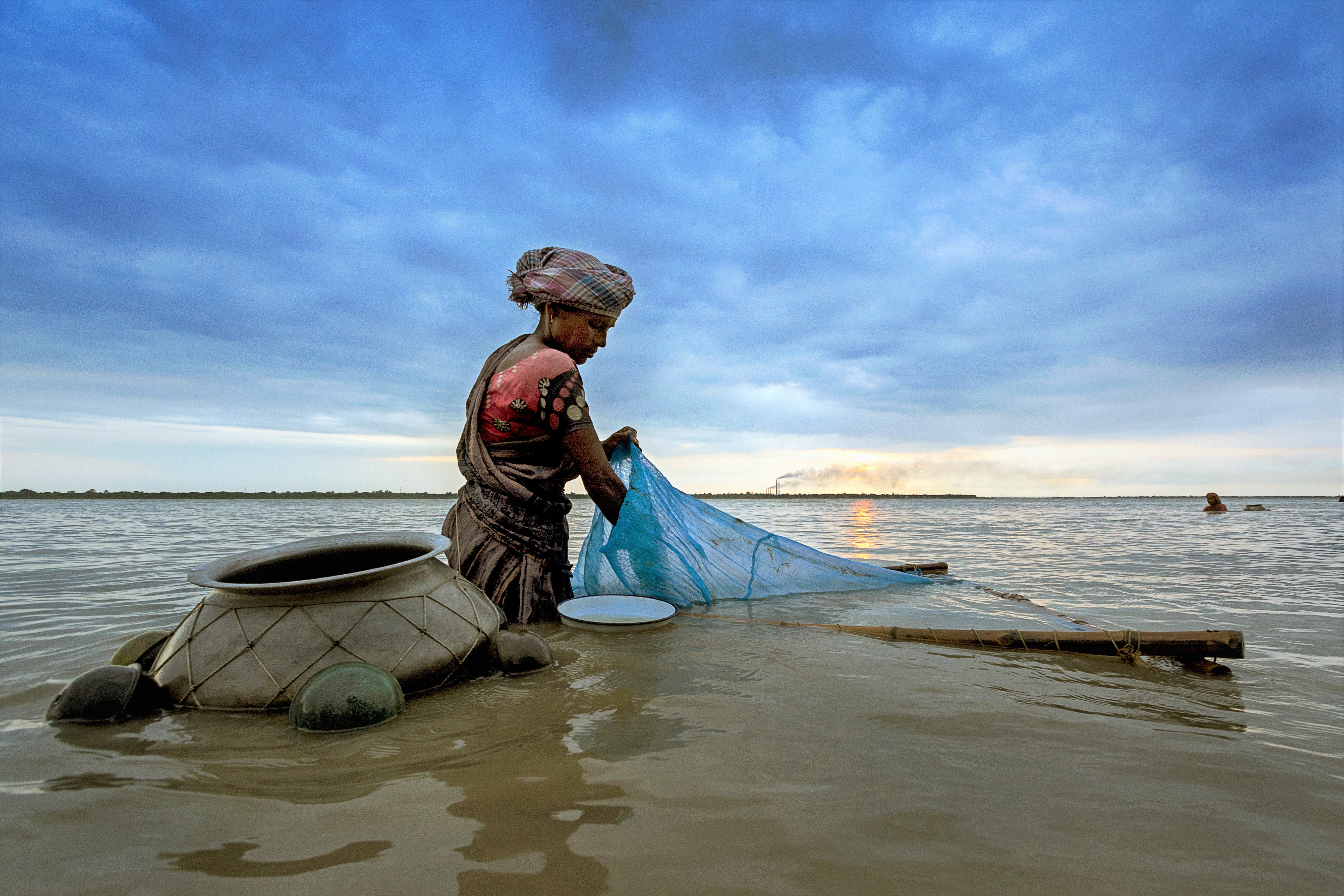 Fisherwoman in the Ganaga River. Photo: Raju Ghosh-National Mission for Clean Ganga.
Fisherwoman in the Ganaga River. Photo: Raju Ghosh-National Mission for Clean Ganga.
The Ganga river is much more than a moving body of water—the 2,500-kilometer river has been an important part of India’s history and identity for thousands of years. It is sacred in the Hindu tradition. Every year, millions of pilgrims bathe in the river to purify themselves. It is also important economically. It accounts for a quarter of India’s fresh water and supports livelihoods in agriculture, fisheries, transportation, tourism, and manufacturing. Over 400 million people—more than a third of the country’s population—live in the river’s basin.
But it is also heavily polluted. Sewage and industrial waste—often dumped in the river untreated—contaminated water used by millions for drinking and bathing. In an assessment carried out by the Central Pollution Control Board, more than half of the wastewater treatment plants in the basin were either not complying the discharge norms, or not working at all. In some areas, cholera has posed a serious health threat to local populations.
Consequently, cleaning up the Ganga through water treatment facilities, inter alia, has been a top priority for government. About 12 years ago, the World Bank provided a $1 billion loan to clean up the Ganga in northern India. At the time, the government was not keen on private sector solutions, and progress was limited. Later, in 2015, the government launched the Clean Ganga program, and requested support from the World Bank Group to address the pollution problem with private sector involvement.
This was the largest river cleanup program in Indian history. It included several components, including cleaning up polluted areas and setting up a series of waste water treatment plants—both newly constructed and refurbished ones. However, the government had concerns about whether these renewed investments could achieve the desired outcome. The concern was valid, as billions of dollars had been invested since 1970s towards the same goal, but without significant results.
These issues were addressed by experts across the World Bank Group, particularly IFC’s Transaction Advisory and the World Bank’s Water and Urban Development Global Practices. The World Bank Group team developed a PPP under a “hybrid annuity” model to build and operate sewage treatment infrastructure. Under this model, the government would pay 40 percent of project costs to private developers on completion of construction (in part through World Bank loans). The remaining costs would be paid in annuities over a 15-year period to private operators, together with operation and maintenance costs. Payments would be linked to performance of the treatment plants. This arrangement provided positive incentives for both government and private operators in the success of the project and ensured sustainable performance of the plants for at least 15 years. This was a paradigm shift in the sector—from a construction-oriented approach to an outcome-based one.
But there was another problem—the private sector was not enthusiastic. The government’s idea was to offer 15-year build-operate-transfer (BOT) contracts, where payments would be made by municipalities. This was too risky for potential private sector operators. The government understood that any kind of public-private partnership (PPP) would have to be carefully structured to attract private sector financing and expertise.
IFC served as PPP transaction advisor in the states of Uttar Pradesh and Uttarakhand. It helped structure an innovative offtake for treated wastewater from a new sewage treatment plant in Mathura, a city in Uttar Pradesh, where the Indian Oil Corporation will use treated wastewater to cool its refinery, which will save 20 million liters of fresh water every day. It also structured PPPs in Varanasi (also in Uttar Pradesh) and Haridwar (Uttarakhand), providing technical, legal, and analytical support. Protecting the environment was a core element to the project. Operators would be allowed to generate revenue in innovative, environmentally-friendly ways, such as selling treated wastewater or generating power through biogas. Most importantly, the government of India agreed to undertake all payment responsibilities under the contract, addressing a key bankability issue.
This time, private sector interest was strong, which demonstrated the strength of this new approach. For example, the Haridwar project attracted six bids; Varanasi attracted eight. These included both Indian and international firms. Typically, the government attracts two or three bids at the most for waste water treatment projects.
The key to cleaning up the Ganga lies in scaling-up the model. Besides the core benefit—providing cleaner water for millions of people living in the Ganga river basin—the pilot is opening new markets for private investment and improving the environment. This first-of-its-kind approach is also being applied in 27 other Indian cities along the Ganga, attracting almost $500 million in private investment for construction of new plants or rehabilitation of existing ones.
These PPPs are expected to have a huge impact on the Ganga and the livelihoods it supports—not to mention the overall health of the people living in the river basin area. But importantly, India now has a scalable model—the hybrid annuity approach—for attracting the private sector in wastewater treatment projects.
Related Posts
Kigali Water: Lessons from one of sub-Saharan Africa’s first water PPPs
5 Trends in Public-Private Partnerships in Water Supply and Sanitation


Join the Conversation